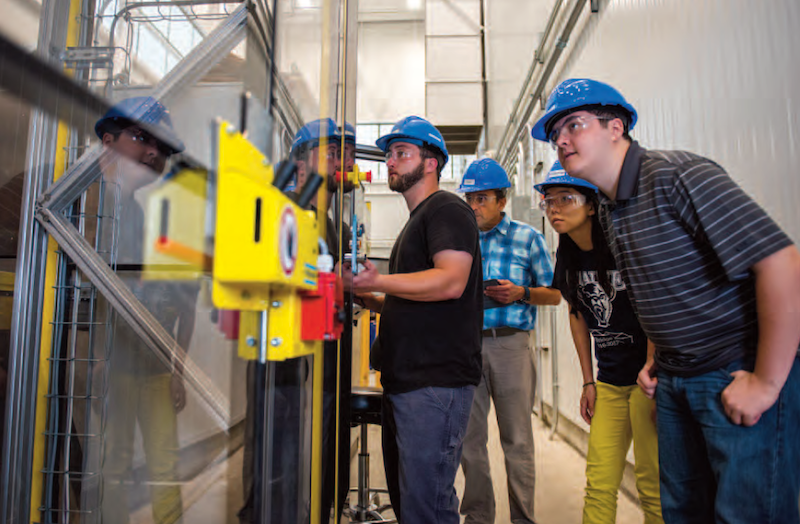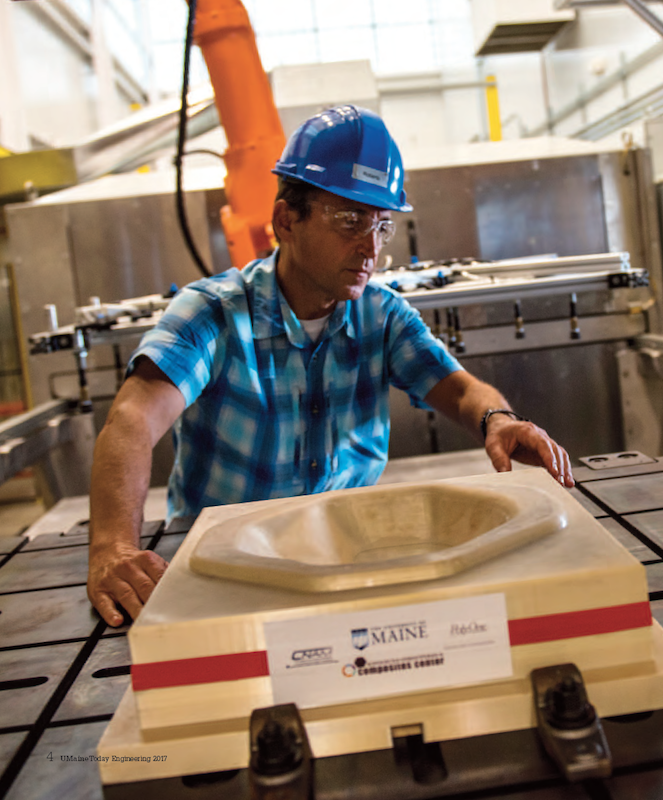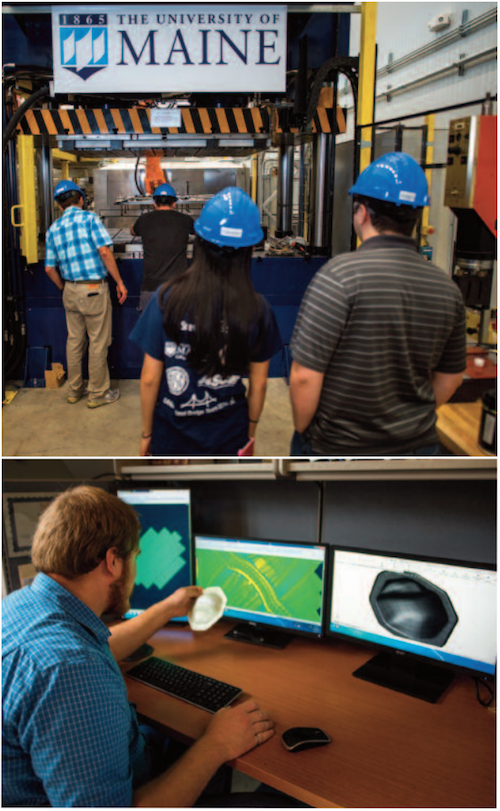
Shaping the Future: Thermoplastics research focuses on advancing manufacturing

Last summer, a team of students, staff and faculty reverse engineered the rear differential cover for a 1998 Dodge Dakota and made a new one. That might seem like a rather routine engineering task unless you know that they created the new cover as a research project using the latest generation of tough, lightweight structural thermoplastics and high-tech equipment at the newest manufacturing lab at the University of Maine Advanced Structures and Composites Center. The Alfond Advanced Manufacturing Laboratory for Structural Thermoplastics, named and supported through a gift from the Alfond Foundation, was created to advance research and development of this new class of structural composite materials, according to Roberto Lopez-Anido, the Malcolm G. Long Professor of Civil and Environmental Engineering at UMaine
It is part of the evolution of the Composites Center, which for the past 20 years has focused on improving composite materials and the processes that create them for structural applications.
“One thing that came up over and over was how to make materials more efficiently, to make them faster, reduce waste, make them recyclable and at a lower cost, and how to make the process so that it is repeatable. Two years ago, we made the strategic decision to move into thermoplastic composites, a family of materials that have evolved into high-end applications,” Lopez-Anido says.
Lopez-Anido has nearly a quarter-century of experience in the mechanics of fiber-reinforced polymer (FRP) composites for construction, durability analysis of composite materials, advanced experimental methods for composites, composites manufacturing, rehabilitation of civil infrastructure, design of composite structures, and structural health monitoring.
Since 1998, he has contributed to advancing knowledge and developing advanced composite materials in civil infrastructure, energy, marine, aerospace and defense applications in the Composites Center.
Lopez-Anido has been the faculty lead in the procurement and implementation of the Alfond Advanced Manufacturing Laboratory for Structural Thermoplastics, located adjacent to the Offshore Wind Lab and Alfond W2 Ocean Engineering Lab.
The new state-of-the-art lab is designed to promote research into long-fiber reinforced thermoplastics.The goal is to develop new automated, advanced manufacturing techniques that reduce cycle time and cost, and can then be transferred into industry.
The process begins with deciding what materials to use for the thermoplastic composite tapes, and how to orient the tapes to create the optimal strength and stiffness to meet specific design standards. The lab equipment can utilize a variety of fiber reinforcement (carbon, glass, etc.) to strengthen the thermoplastic material tape.
Computer simulations and models help determine the best materials and orientation for the end product. Often, as in the case of the differential cover, that process requires one or more trial-and-error tests to find the best layup, heating and processing parameters for the thermoplastic composite tape.

enters a post-processing cell, where machining, joining,
cutting, grinding and drilling operations can be performed.
The post-processing cell utilizes ultrasonic resistance and
thermal welders to join thermoplastic parts and assemblies.
Bottom: Graduate student Phil Bean performs modeling and
computer simulation of the materials and thermoforming
process to optimize the design and manufacturing method.
“When you work with these materials, you need first to design the materials. That implies that you understand what materials to select and how to make it,” Lopez-Anido says.
“Materials engineering and manufacturing go hand-inhand, and that’s a very interesting aspect of this process. You need to both understand how to characterize and manufacture the materials in order to optimize the process.”
The new equipment is set up based on a production line to manufacture commodity, engineering and performance thermoplastic materials, with processing temperatures up to 840 degrees F. Once the material is designed, the production process proceeds in five steps, according to Lopez-Anido.
First, the mold is created using additive manufacturing via a 3-D printer. Then, based on the predetermined design, spools of reinforced thermoplastic tapes are cut to length, oriented to meet specific design standards and ultrasonically welded to form a tailored blank using an automated tape placement machine.
An industrial robotic arm moves the blank to a thermoforming cell — an infrared oven — where it is heated to a prescribed temperature for forming. The robot then moves the heated blank to the 700-ton hydraulic press, where it is formed over the 3-D printed molds. The final step in the process is the finishing — sanding, polishing, drilling, welding and whatever else is needed for the prototype.
The lab uses this process to develop and test materials and manufacturing methods that can benefit industry. The automotive, transportation or building industries are the most common areas where these materials are used today.
The materials that students and faculty are working with also have applications in the marine and aerospace industries. They can be adapted to exterior or interior uses, and can be engineered for a variety of specifications, such as withstanding weather and ultraviolet radiation in outdoor applications, or limiting smoke and toxicity in the event of fires in indoor applications.
They also can be adapted to different manufacturing processes — a stamping process like the one used for the differential cover, or an extrusion process in which materials are fed into a heated mold, pulled from the other end and cut to length.
The goal, Lopez-Anido says, is to find new ways to use this new class of thermoplastic composites in industrial applications.
“We do not compete with industry,” he says. “We have a process that is almost at industrial scale in terms of size and speed. It’s not a benchtop process. That means that a company can come here and test a prototype without stopping its production line. Essentially, we can become the experimental production line. Because of the scale, they can transfer the technology directly.”
Lopez-Anido and colleagues already are planning for a much larger lab with larger equipment. For example, the available 3-D printer, although larger than personal models, can “print” parts measuring 3 feet, by 3 feet by 2 feet.
He envisions one day having 3-D printing capabilities for 15 feet by 8 feet by 45 feet parts, allowing the Composites Center to develop and test larger molds at full size.
He refers to a looping video display in the lab that shows a tooling device shaping a scaled-down mold for a sailboat hull that had been created on a 3-D printer at another facility. With the larger printer, he says, the lab would have the ability to create that same full-size hull mold.
Developing and testing that kind of full-scale technology could be a boon to the boatbuilding industry by reducing the time and the cost of creating hull molds.
The large-scale capability could open up research in other areas, including floating platforms and blades for wind energy technology.
It is an exciting time for the lab, where these new technologies offer hands-on learning opportunities for students, he says. It also puts undergraduate and graduate students in contact with industry partners and suppliers, which can often lead to good jobs after graduation.
“(Here) they can go beyond the boundaries of their separate (engineering) departments and work in teams. That works also for the faculty. “I love my department, but here I get to collaborate with people in other disciplines and to do things I could not do just by myself,” says Lopez-Anido.
Lopez-Anido sees a great future for the Alfond Lab, with more and closer ties to industry, helping Maine companies provide solutions to manufacturing problems.
“This is probably the most important lab in the state for industrial manufacturing and testing applications. It is a great resource for Maine,” he says.
